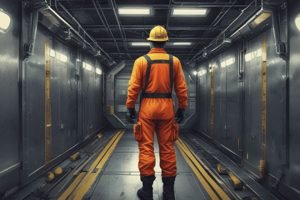Podcast
Questions and Answers
The water level in the confined space should be below 15 cm (6 in.) before entry.
The water level in the confined space should be below 15 cm (6 in.) before entry.
True (A)
If water is present in the confined space, a dry metal platform shall be available for use.
If water is present in the confined space, a dry metal platform shall be available for use.
True (A)
The air in the confined space must be checked for explosive gases, fumes, and vapors before entry.
The air in the confined space must be checked for explosive gases, fumes, and vapors before entry.
True (A)
The oxygen content in the confined space does not need to be checked before entry.
The oxygen content in the confined space does not need to be checked before entry.
Carbon monoxide levels do not need to be checked if there has been any burning or products of burning involved.
Carbon monoxide levels do not need to be checked if there has been any burning or products of burning involved.
If any dangerous gases, fumes, and vapors are present, the area should be entered immediately to assess the risk.
If any dangerous gases, fumes, and vapors are present, the area should be entered immediately to assess the risk.
Approved breathing apparatus and personal workers entering the confined space.
Approved breathing apparatus and personal workers entering the confined space.
Workers can enter a confined space without a watcher as long as they have breathing apparatus.
Workers can enter a confined space without a watcher as long as they have breathing apparatus.
Smoking is allowed in confined spaces.
Smoking is allowed in confined spaces.
Manholes, tank openings, or other openings left unattended should be protected by barricades and warning signs. How should unattended openings at night be protected?
Manholes, tank openings, or other openings left unattended should be protected by barricades and warning signs. How should unattended openings at night be protected?
Warning labels on containers of hazardous substances should be in _____ shapes.
Warning labels on containers of hazardous substances should be in _____ shapes.
Markings on labels should be in _______ background.
Markings on labels should be in _______ background.
Who is primarily responsible for correctly labeling containers of hazardous substances?
Who is primarily responsible for correctly labeling containers of hazardous substances?
How often should the atmosphere of workrooms be tested for concentration of hazardous substances?
How often should the atmosphere of workrooms be tested for concentration of hazardous substances?
Flashcards are hidden until you start studying
Study Notes
Confined Space Entry
- Water level in the confined space should be below 15 cm (6 in.) before entry.
- A dry metal platform should be available for use if water is present in the confined space.
- Air in the confined space must be checked for explosive gases, fumes, and vapors before entry.
- Oxygen content in the confined space must be checked before entry.
- Carbon monoxide levels must be checked if there has been any burning or products of burning involved.
Mechanical Handling Equipment and Aisles
- Sufficient safe clearance must be ensured when using mechanical handling equipment in aisles and passageways.
- Aisles and passageways must be kept in clear and good repair.
- Permanent aisles and passageways should be appropriately marked.
- Materials stored in tiers should be stocked, blocked, interlocked, and limited in height.
Storage Areas
- Storage areas must be kept free from accumulations of materials to avoid hazards.
- Vegetation control should be exercised in storage areas when necessary.
- Clearance signs should be provided to warn of clearance limits.
- Derail and/or bumper blocks should be installed on spur railroad tracks to prevent rolling cars from contacting other cars or entering work areas.
Openings and Pits
- Manholes, tank openings, or other openings left unattended should be protected by barricades and warning signs.
- At night, unattended openings should be protected beyond barricades.
- Covers and/or guardrails should be provided to protect personnel from hazards of open pits, tanks, vats, and ditches.
Hazardous Substances
- The process or operation involving hazardous substances can be carried out in an air-tight enclosure to prevent personal contact with harmful substances.
- If airtight enclosures cannot be used, harmful substances should be controlled by removing them at their point of origin.
- Warning labels on containers of hazardous substances should be in rectangular shapes.
- Markings on labels should be in black on white background.
Labelling and Testing
- Manufacturers are primarily responsible for correctly labelling containers of hazardous substances.
- The atmosphere of workrooms should be tested for hazardous substances annually.
- Ventilation and exhaust equipment should be inspected and tested periodically.
- Cleaning of floors, walls, and equipment in workplaces with toxic substances should be done daily by wet brushing or sweeping.
- Workers exposed to irritating or toxic substances should promptly report any physical complaints.
- The employer should maintain accurate records of employee exposure to potentially toxic materials for legal requirements.
Studying That Suits You
Use AI to generate personalized quizzes and flashcards to suit your learning preferences.




